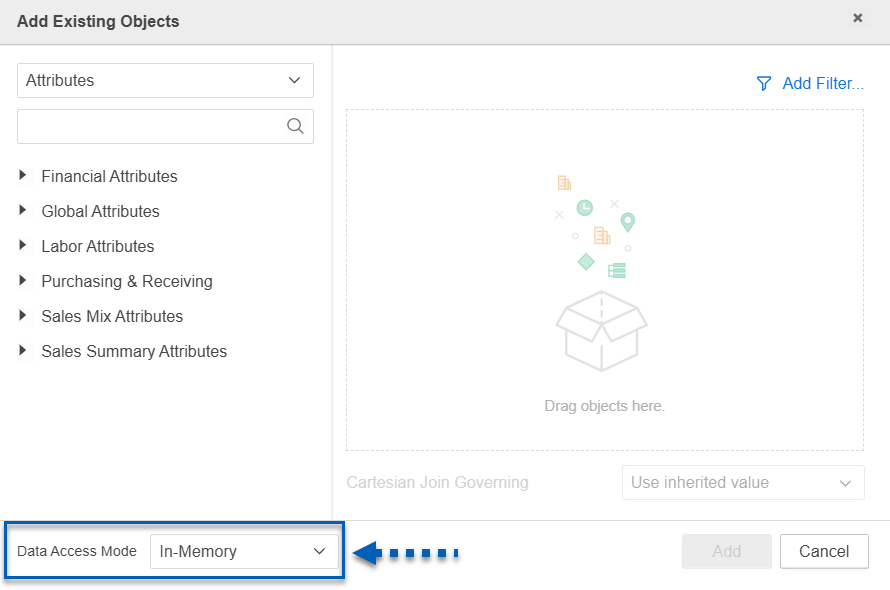In R365 Intelligence, dashboards can be built using datasets or individual objects. Understanding when to use each approach helps ensure accuracy, maintain performance, and avoid errors during dashboard creation.
Video - How to Use Datasets vs Objects Live vs In-Memory
Datasets
A dataset is a pre-configured collection of related attributes and metrics designed to work together without errors. Datasets are optimized for handling large amounts of data and reduce the need for users to manually manage object relationships. Learn more about adding data by dataset.
When to Use Datasets
Complex Dashboards: Use datasets when building dashboards that require multiple attributes and metrics within a specific domain (e.g., Sales, Labor).
Cross-Domain Analysis: Datasets simplify joins across multiple domains, such as combining Sales and Labor data.
Error Prevention: Datasets are pre-joined, ensuring all included objects work together correctly and reducing the risk of join errors.
Large Data Sets: For reports requiring most of the objects in a dataset, loading the dataset ensures consistent and reliable results.
Considerations When Using Datasets
Initial Load Time: Datasets may require a slight delay during the initial load as all data is brought into memory.
Granularity Matching: Day-Level datasets (e.g., Sales by Day) can be combined with other Day-Level datasets. However, Interval-Level datasets (e.g., Sales by Hour) should not be mixed with Day-Level datasets to avoid inconsistencies.
Mixing Data Across Datasets
When combining data from multiple datasets:
Ensure data granularity matches across datasets:
Combine Day-Level datasets (e.g., Sales by Day, Labor by Day) together.
PMIX by Day is an exception among Day-Level datasets, as it represents data for 7 days rather than a full month. When PMIX by Day is included, ensure its time frame aligns with other datasets in the dashboard.
Combine Interval-Level datasets (e.g., Sales by Hour, Labor by Interval) separately.
Best Practice
Do not mix Day-Level datasets with Interval-Level datasets in the same dashboard, as this can cause inconsistencies.
Instead, create separate dashboards for each granularity level.
Objects
Individual objects allow users to select specific attributes or metrics from a dataset without loading the entire dataset. This approach is useful for smaller, focused reports or when fewer data points are required. Learn more about adding data by existing objects.
When to Use Objects
Simpler Dashboards: Use individual objects when building dashboards that require only a small number of attributes or metrics.
Use individual objects for smaller dashboards where performance is a priority.
Performance Optimization: Avoid loading unnecessary data by selecting only the objects needed for the report.
Customization: Users familiar with object relationships can choose individual objects to tailor reports more precisely.
Considerations When Using Objects
Join Management: Users need to ensure selected objects are compatible to avoid join errors. Objects grouped in the same dataset folder within Intelligence are designed to work together without issue.
Mixing with Datasets: Combining datasets and individual objects in the same dashboard is not recommended, as it may introduce join errors or inconsistencies.
R365 Best Practice
When adding data by object, R365 recommends adding the objects using the In-Memory data access mode.
Quick Guide Datasets vs. Objects
Scenario | Recommended Approach |
|---|---|
Large or complex dashboards | Use datasets |
Small focused dashboards | Use individual objects |
Using most objects in a dataset | Use datasets |
Cross-domain dashboards (Ex. Sales + Labor) | Use datasets |
Combining specific attributes or metrics | Use individual objects |
